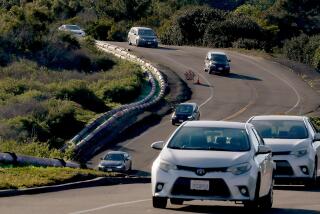The city that wants fewer bikes, if any

- Share via
Calcutta, India, would seem to have reached some sort of bicycling nirvana. In the city of 5 million people in a metropolitan area nearly triple that size, more bicycle rides are made each day than forays by car.
So much for that progressive state of things.
The BBC reports that the city is banning bicycles on most of its thoroughfares during the day — 174 of them -- saying that because its streets are narrow, there is too little room for bicycles and cars to share the road. And guess which vehicles it decided should get to stay? You’ve got it: the space-hogging, gas-consuming, pollution-emitting ones.
FULL COVERAGE: Sharing the road in L.A.
I’m sure there are a few Los Angeles drivers who, having been cut off by a biker running yet another stop sign or hogged a traffic lane while riding 5 mph, think Calcutta’s on to something smart here. Sharing the road is dangerous, and I have my doubts about whether anything short of dedicated streets for bikes will achieve the necessary level of safety.
But in greater Calcutta, millions of people cannot afford a car and depend on their bikes to get around. Yet there appears nothing besides the smaller, out-of-the-way streets where bikes will be welcome. And even there, the roads will not belong solely to them and probably won’t be all that safe.
Calcutta already has what we find so difficult to achieve: a non-car society, with a hefty portion of the population who avoid polluting the air and who benefit their own health by pedaling as a form of transportation. The city doesn’t have to persuade people that bicycling is a smart transit choice; it just has to stay out of their way.
ALSO:
McManus: A way out for the GOP
L.A. Unified’s iPad plan doesn’t compute
This post is part of an ongoing conversation to explore how the city’s cyclists, drivers and pedestrians share and compete for road space, and to consider policy choices that keep people safe and traffic flowing. For more: latimes.com/roadshare and #roadshareLA.
More to Read
A cure for the common opinion
Get thought-provoking perspectives with our weekly newsletter.
You may occasionally receive promotional content from the Los Angeles Times.










